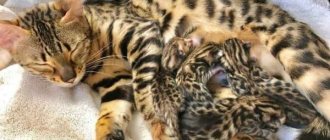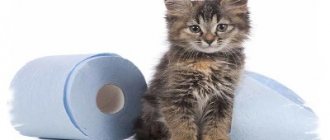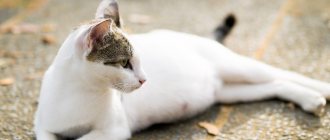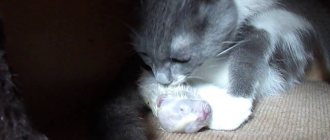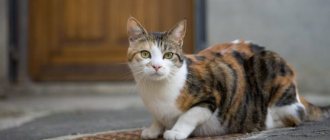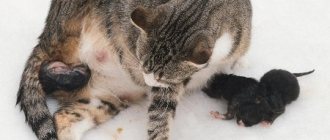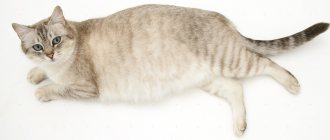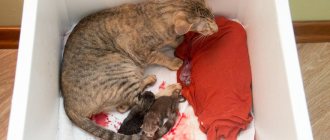If you are a happy cat owner, then without sterilizing your pet, sooner or later she will give you a litter of wonderful kittens. It’s good if this event is planned, then the cat will receive the nutrition, care and attention of all family members necessary during pregnancy. In this case cat giving birth will be carried out under the close supervision of the owner or veterinarian, which will help cope with possible difficulties or complications.
Although childbirth is a natural process, unplanned situations cannot be ruled out, so it is worth preparing for the climax long before it begins, which is what this article will help you with.
global $ads_google; //data-ad-slot=”2475549904″ $ads_google = empty($ads_google) ? false : true; ?> if ($ads_google == false) {?> $ads_google = true; ?> } ?>
How to prepare a cat for birth
A caring owner begins to prepare the cat for childbirth even before mating begins.
It is important to make sure that the pussy is healthy: an active lifestyle of the animal will contribute to the normal course of pregnancy and childbirth. However, towards the end of the term, it is better to ensure that the cat does not try to “take heights”, does not jump from cabinets and other high objects in the house: it can easily fall on its stomach.
On the contrary, you should try to stimulate British cats during pregnancy - these sloths are quite capable of lounging on the bed for a long period of time. And low mobility will not lead to a good result.
It is better to contact the veterinary clinic in advance and find out whether you can get an urgent consultation at any time of the day at “hour X”, and whether the institution provides the opportunity to give birth to cats at home .
Preparing the birth site
Just as a woman needs a breeding room, a cat needs a place to give birth to her offspring. It is best if it is something resembling a house for giving birth to a cat. In this place, not only will the fluffy balls be born, but also their first weeks of life will pass.
Why is it so important to prepare a place for your cat to give birth in advance? If she does not feel calm and protected, she will begin tossing around before the onset of labor, and then frantically dragging the kittens in search of a safe place.
How to help your beloved pussy during childbirth? Take care of everything in advance! What to make a house from: any spacious box will do, preferably with a removable top lid. A disposable absorbent diaper is placed in it. It makes sense to prepare in advance all the items that will help during obstetrics and place them close to the “maternity” house.
What is not recommended to do before labor begins
To ensure a smooth birth, pay attention to the list of things you should not do:
- irritate the woman in labor with loud screams, numerous guests, parties;
- actively feel the stomach, as you may accidentally injure the cat or kittens;
- Give your cat medications on your own without consulting a specialist;
- ignore vomiting, discharge and changes in the behavior of the pregnant woman;
- allow your cat to come into contact with animals whose health status you do not know;
- allowing you to sleep in a dirty place, handling the animal with dirty hands, frequently changing the linen in the cat’s sleeping area;
- use chemicals to clean the house.
First birth of a cat
Starting from 7-9 months, the cat is capable of reproduction. But don’t rush things: it’s much better if the pussy turns one year old, when 3-4 heats have passed. If the mating is successful, the cat's birth calendar will help calculate the timing of the birth of the offspring.
The first time is scary for everyone: both the cat and the owner. But nature took care of the animal’s strong instincts, so sometimes it’s enough for a person to just be nearby.
The first birth is quite normal if the cat is healthy. First, contractions intensify, followed by a reduction in the intervals between them.
After pushing, the baby appears, but first amniotic fluid will come out of the birth canal. The cat will want to sit down while the kitten is coming out, this should not be allowed!
The interval between the appearance of kittens during the first birth can frighten the owner - a break of up to one and a half hours is considered the norm, and labor itself lasts from several hours to one day. In some cases, labor lasts up to 36 hours
Since the cat is inexperienced, you can help her during childbirth and cut the umbilical cord with scissors at a distance of 2 cm from the kitten’s belly.
When labor is too long
Now that we've explained how long it takes to deliver kittens, we should know that veterinary intervention is recommended in some circumstances. These may include:
- If more than 2 hours have passed since contractions began.
- Very weak contractions for 2 to 4 hours.
- After 20-30 minutes, very strong contractions without expelling the kitten.
- If we see obstruction of the birth canal, regardless of time.
Any of these signs could indicate a problem with the mother or babies and we would have to contact a veterinarian. They will be able to best diagnose the problem and even perform a caesarean section if necessary.
Signs of labor in a cat
In order not to miss the onset of labor, owners carefully observe how the cat behaves before giving birth:
- a few weeks before lambing, you can easily notice the enlargement of the mammary glands;
- 1-2 days before the important moment, colostrum is slowly released;
- unusual behavior of a cat is difficult to ignore: this is the search and arrangement of a “nest”, changes in mood, anxiety, desire to hide, or extraordinary affection;
- drop in body temperature to 37°;
- appetite may disappear completely;
- The cat often licks the genitals.
The main thing is to let the pet feel that she is not alone: talk to her tenderly, pet her, arrange a House for her in a secluded corner.
global $ads_google; //data-ad-slot=”2475549904″ $ads_google = empty($ads_google) ? false : true; ?> if ($ads_google == false) {?>
$ads_google = true; ?> } ?>
Precursors of childbirth and symptoms of an imminent birth of a cat...
External manifestations of imminent labor are called precursors and are similar in dogs and cats.
- Animal behavior,
- lactation,
- appetite,
- frequent urination,
- prolapse of the abdomen,
- loop softening,
- thermometry.
A week before giving birth, the animal’s behavior changes
. This is due to the growth of the hormone estrogen, which causes contraction of the muscle fibers of the uterus (contraction). This increases anxiety and stimulates the animal to build a nest. Dogs begin to dig, cats begin to build a “nest.” It is recommended to provide the animal with a box or house in which it will feel safe.
Lactation
– does not always appear and not for everyone. This is not a completely accurate sign of the harbingers of labor. In some dogs it may appear from the 40th day of pregnancy, and in others only after birth.
Appetite.
In general, the appetite before birth worsens, or may become selective, that is, the animal may become more picky about food.
There are animals that eat even during the birth process, but these are exceptional cases, of course. And some people completely lose their appetite before giving birth, which is a very bad symptom and can lead to ketoacidosis
. If the animal does not eat for more than a day, and labor does not begin, you should consult a doctor. So, everything is individual.
Frequent urination
– normal before labor, usually associated with increased uterine contractions. Urinating in inappropriate places can be an involuntary leakage of urine. Sometimes the animal simply does not have time to “run” or wait until the walk.
«Abdominal prolapse
“- is considered perhaps the surest sign of imminent labor, but it is associated not with the harbingers of labor, but with an increase in the weight of the fetus. The most active weight gain occurs in the last weeks, and the growth of babies continues until the very birth, so the stomach drops under the gravity of the uterus. The more fetuses there are, the more pronounced the prolapse of the uterus is. If the animal has only one fetus, then uterine prolapse may not be noticeable at all.
Loop softening
– she is preparing for childbirth, so she becomes softer and more pliable a couple of days before giving birth.
One of the most accurate precursors of labor is Thermometry
. It is of key importance in determining the period of labor.
For control, it is advisable to measure the temperature 1-2 times a day, starting from the 55th day of pregnancy. When we know what it usually is, we can determine when they will start. A drop in temperature by 2 degrees (to 37) usually indicates the imminent onset of labor.
Physiology of childbirth
In ripened fetuses, cortisol (stress hormone) is formed, which passes the placental barrier, it stimulates the mother’s production of prostaglandins. Prostaglandins dissolve the corpus luteum of pregnancy, which produces the pregnancy hormone progesterone. The amount of progesterone drops sharply and labor begins.
In addition, the amount of estrogens increases, which increases the sensitivity of receptors to oxytocin. The contraction of the uterus increases. The hormone relaxin, produced by the placenta, stimulates the dilatation of the cervix and prepares it for the expulsion of the fetus.
Stages of lambing for a cat
Labor is divided into three stages:
- Contraction of the uterus and its gradual opening. The external symptom is discharge - the mucous plug that covers the entrance to the cervix comes out. Contractions appear and become more frequent.
- Increased frequency of contractions, complete opening of the cervix. The movement of the fetus along the birth canal into the second phase is accompanied by the mother cat’s attempts to push the baby out: the animal tenses. Kittens are born mainly in the amniotic sac. If the new mother did not help the child cleanse himself of it and did not lick it, then a person should help - carefully use scissors to make an incision on the bubble in the area of the muzzle, and the kitten itself is wiped with a cloth. Usually the female, on her own, carries out the procedure of breaking the bladder and licking its remains from the kitten’s body. The duration is 5-60 minutes.
The kitten did not come out an hour after the start of this stage? Urgent call to the vet!
- Once the baby is born, the placenta begins to come out, which the mother can eat after the kitten has been licked. It is better to remember how many placentas came out - there should be as many of them as kittens.
The kitten finds the nipple, labor resumes, and the next cub appears. The interval between two kittens can be from 10 to 60 minutes.
The whole process takes on average 6 hours.
Nuances of the prenatal period in a cat
The pregnancy time of a cat directly depends on its breed and health status. To avoid troubles, you need to monitor changes in the behavior of the expectant mother, observe the well-being of the animal, and have basic knowledge of physiology.
- Signs of pregnancy. Be prepared for the fact that during the first 2.5 weeks it is impossible to detect pregnancy in a cat without an ultrasound examination. And already in the third week, certain changes begin to occur in the animal’s body. She may vomit and become lethargic, and her mood will change at lightning speed. In addition, you will notice that the nipple area has become significantly pinker. By 6-7 weeks, the belly will become rounded, and the mammary glands will greatly increase.
- Duration of pregnancy. As mentioned earlier, the duration of an animal’s pregnancy depends on the health and breed of the pet. The most popular Scottish cats now bear cubs from 63-67 days from the moment of mating, and in British cats pregnancy lasts 64-66 days. Persians carry babies longer than all other breeds, and Siberian breeds give birth a little earlier. On average, this figure is 62-66 days, and in case of complications or any pathologies, the duration can be reduced to 57 days.
- How is pregnancy progressing? Complications often arise when a cat gives birth for the first time, and mainly in purebred pets bred artificially. During such periods, the animal’s general condition noticeably worsens, and the expectant mother begins to whine in her sleep, stops eating, and becomes apathetic. The expectant mother does not want to get up on her paws, and she practically goes into “lying down” mode.
- Precautionary measures. When pregnancy is diagnosed, try to carry your pet less often, and do not lift or press the woman in labor, especially when her stomach is already enlarged. Also, you should not knead your belly in the hope of finding the offspring, as there is a possibility of harming the pet. It happens that, without meaning to, the owners accidentally touch the cat while walking, and it hisses. This is a defensive reaction, because the mother is already trying to protect her future offspring. Try to avoid this, as there is a possibility that such cats will become aggressive after lambing.
Giving birth to a cat at home
A responsible owner should know how to give birth to a beloved cat . First, prepare everything you need:
- a house that the cat will examine and “accept” in advance;
- towels or absorbent diapers;
- clean cloths or gauze;
- thick silk thread;
- scissors with rounded ends;
- alcohol for disinfecting scissors;
- hydrogen peroxide;
- streptocide in powder form;
- a pipette or syringe that can be used to suck out liquid from the baby’s nose;
- afterbirth bowl;
- warmer.
Easy birth
A cat's birth is considered easy when there is no need for human intervention. It will be enough to simply be close to the woman in labor. The main thing you need to take care of is that the mother should not accidentally crush her offspring. It is also important to monitor whether each afterbirth has come out. If suddenly some placenta is missing, then the cat’s discharge is observed for several more hours; the process may take a little longer.
An easy birth is not characterized by pus, mucus and blood.
Middle birth
Sometimes some complications arise during home birth. If the process is delayed, you need to stroke the cat from the side of the neck to the uterus.
If the cat is distracted and does not chew the umbilical cord, a person does this, treating the cut site with iodine. The newborn may not breathe: minor resuscitation will be required. The respiratory tract is cleared of mucus using a pipette or suction, and the oral cavity is examined. Anything that should not be there is removed with a rubber bulb. If breathing does not appear, the baby is picked up and carefully folded in half - several times in a row. You can also rub the baby with a rough towel and gently shake it upside down.
Difficult birth
global $ads_google;
//data-ad-slot=”2475549904″ $ads_google = empty($ads_google) ? false : true; ?> if ($ads_google == false) {?> $ads_google = true; ?> } ?> Childbirth turns out to be difficult when, despite everything, the kitten is not born on its own: the baby gets stuck in the birth canal, or two babies try to be born at the same time. Before calling the veterinarian and hoping for a caesarean section, there are a number of independent steps to take.
You need to understand that it is better to act and help the cat during childbirth than to later regret the misfortune that happened.
If labor stops or its result is zero, the cat can be taken for an ultrasound or x-ray. It may turn out that the kitten has died, or it is extremely large and has blocked the exit.
Sometimes it is necessary to turn the kitten over: a gloved index finger, lubricated with Vaseline, is inserted into the vagina. You need to carefully push the baby back and try to turn him over. If it is simply stuck, then it is picked up under the hanger and carefully pulled out with attempts.
What absolutely should not be done
Sometimes the owner of a mustachioed friend can harm the animal due to inexperience. To prevent this from happening, take a close look at the list of things that are strictly forbidden to do when giving birth to a cat:
- Do not pull a newborn cat by the head or neck. It is also forbidden to pull too hard on just one paw.
- It is prohibited to use antiseptics that are intended for treating human wounds.
- Do not allow a giving birth cat to eat more than two placentas.
- It is prohibited to turn on bright lights in the maternity ward. Moreover, it should not be included in the first 2-3 weeks of a kitten’s life, as this can cause cataracts.
- In the first 2-3 hours, try not to pick up newborns. Leave them in the care of the mother: she will lick and warm the babies on her own.
Did you know? The cat sees practically nothing half a meter in front of him. That is why she can look for a long time for a tasty treat that you gave her right under her nose.
Never panic. Before giving birth, check your first aid kit and get ready, because usually there are no problems.
Induction of labor
If the due date has come, the cat’s body temperature has dropped to 37°C, more than two days have passed, then you need to know how to induce labor in a cat. First, they try simple remedies: massage the tummy and nipples: this will cause the production of oxytocin, and it will start the process of contractions. It is dangerous to administer oxytocin on your own - physiological unpreparedness for lambing can lead to cervical rupture.
If two days have already passed, signs of labor are evident, but the process has not started, then contact a veterinarian.
Infertility and multiple pregnancy: what affects fertility
There are many theories why cats give birth to different numbers of kittens and what this depends on. Among the most widespread are:
- Influence of nutrition. If there is insufficient or poor quality food, the cat's chances of becoming pregnant are reduced. Nature seems to protect dead and weak kittens from being born. This is called nutritional infertility.
- Obesity. At the same time, many animals stop estrus, which indicates serious hormonal changes in the body. And in this condition, pregnancy cannot occur at all.
- Comfortable living conditions: cleanliness, comfort, favorable emotional climate, absence of stressful situations and other factors.
- Heredity. If the cat's mother gave birth to a small number of kittens, then you should not expect multiple pregnancies from your pet.
- Diseases of the reproductive system that affect the ability to conceive. For example, endometritis, pyometra and others.
- Temperament of a cat. Ovulation in cats occurs under the influence of the active behavior of the male during intercourse. Accordingly, the more active the partner is, the more eggs will be released and their fertilization will occur. If the cat is phlegmatic, there will be fewer kittens.
- Just like people, pets can be incompatible with each other. Therefore, if there is no pregnancy from a particular partner, you can try to change him.
- The quality of a cat's sperm also plays an important role. With prolonged abstinence or frequent sexual intercourse, it decreases sharply. It also depends on the living conditions of the animal, the psychological climate, healthy food, the general condition of the body, the absence of chronic diseases, etc.
- Hormonal imbalance in a cat, in which little follicle stimulating hormone (FSH) is released, which leads to the release of a small number of eggs. This, in turn, also applies to low-fertility pregnancies.
- Weight, age and general condition of the expectant mother’s body. Older cats give birth to fewer kittens.
- Pedigree and barn cats have different fertility rates. The latter most often give birth to many kittens, and this trend does not change with the age of the pet. Animals with blue blood have a tendency to have low-fertility pregnancies.
- Some breeders believe that the number of offspring is related to the number of matings. After the first time, one or two kittens are born, by 7 - the maximum possible for a given individual, and then their number decreases again.
- Another opinion is that the faster intercourse occurs from the beginning of estrus, the greater the number of new pets will be born.
All these theories have both confirmation and refutation. For example, if you adhere to the opinion that nutrition and stress affect pregnancy, it turns out that yard cats that do not have owners should not give birth at all, but they bring the maximum number of pets and calmly bear and raise them in the future. At the same time, females who are in calm home conditions with sufficient nutrition and care cannot always please their owners with kittens.
Also read about discharge from a pregnant cat.
Possible complications
Cats are naturally strong creatures, but sometimes complications still occur. This was especially influenced by breeding selection. Observations have shown that Persian and Siamese cats often “delight” their owners with dystocia—difficult childbirth. When choosing a female kitten, it is better to immediately ask the breeders how the birth of kittens for this particular breed goes.
Bloody discharge in a cat after birth
Sometimes during labor a cat notices ichor oozing out. This is most often described as “my cat peed blood.” This is quite normal if there is little bleeding.
The alarming symptom normally disappears completely two days after lambing.
Sometimes there are really serious problems, expressed by bleeding from the vagina. Blood may have accumulated in the uterus, or if there are tears in the uterus or vulva. If a caesarean section was performed, then the blood may indicate broken sutures. But this is not just some bleeding, but really heavy bleeding that does not stop after 10 minutes. In this case, urgent veterinary help is needed.
The cat does not have milk after giving birth
First, felines, like humans, secrete colostrum. But when does a cat produce milk after giving birth? Colostrum is milk, only with a slightly modified composition. Colostrum contains a huge amount of maternal antibodies. After 2-3 days, colostrum is replaced with full-fledged nutritious milk. Thanks to nature, which, through the process of evolution, “thought out” everything, and the cat itself feeds its offspring!
But what if the cat gave birth, but there is no milk? There are several reasons: stress during a difficult birth, fear of the first-born cat, dormant maternal instinct.
The animal is provided with a comfortable environment, a nutritious, balanced menu, and milk is not spared. The bowl with food and drink is placed closer to the cat family. If food is far away, the mother may fear for her offspring, which also affects the quality and quantity of milk.
If milk does not appear, you will have to feed the newborn kittens yourself.
After giving birth, the cat came out with a bladder
Sometimes you can see a bubble coming out of the cat. Usually, this is the amniotic membrane - the kitten was in it before birth. During the normal course of labor, such a bubble ruptures inside the animal.
Sometimes during labor a bubble appears first. The cat may try to tear it apart, but the owner’s job is to prevent her from doing this. As soon as the bubble with the kitten comes out completely, you can break the shell.
If after giving birth a cat has an empty bladder, this is simply a developmental variation within the cat’s body, and it does not cause problems.
After childbirth there was a belly
global $ads_google;
//data-ad-slot=”2475549904″ $ads_google = empty($ads_google) ? false : true; ?> if ($ads_google == false) {?> $ads_google = true; ?> } ?> The cat has become a mother, the kittens are snoring nearby, but the pet still has a belly. This is the probability that not all babies were born at once. It is optimal to wait 12 hours and allow the natural process to take its course. But if the next day has already arrived and nothing has happened, then you definitely need to consult a veterinarian.
To make sure that not all the babies have come out, the cat’s stomach is felt. It is especially dangerous if the kitten is dead inside. If the baby inside cannot be felt, there is a possibility that the pet has intestinal problems: constipation, flatulence, feces, helminthic infestation.
Eclampsia in cats after birth
Eclampsia is a severe postpartum condition that is not that rare. Due to the production of milk, the amount of calcium in the animal’s blood decreases, and it may even cease to be absorbed by the body.
Signs of eclampsia:
- excessive saliva production;
- poor coordination of the animal, confused movements;
- concern;
- convulsions;
- the temperature rises.
If you notice these warning signs, contact your doctor immediately! Further development of the complication leads to death.
To avoid such danger, during pregnancy and after the birth of kittens, the cat is given calcium supplements. But first, they take a blood test to determine the need for such prevention.
Cat doesn't eat after giving birth
The norm is that a cat should not be hungry for another 5-6 hours after birth.
The main thing is that the pet does not refuse water. If the cat has not eaten for a long time, first she is offered broth. Low-fat cottage cheese, kefir, and even sweet tea can cause your pet’s appetite.
If your cat develops diarrhea, it means she has eaten too much afterbirth. With such a disorder, refusal to eat is understandable. The treatment will be sorbents and Ringer's solution. This will relieve intoxication. Enveloping substances will help protect the mucous membranes. Ringer's solution will prevent dehydration.
As soon as the cat feels better, she will ask for food herself.
The cat does not go to the toilet after giving birth
The body and uterus will gradually recover after the end of labor, so the animal does not rush to the tray. Don't panic if you brought the tray closer to her and the new mother ignored it.
It is considered normal if the cat does not go to the toilet after giving birth for up to 4 days.
The lack of desire to visit the latrine may be caused by exhaustion - all the liquid goes into the milk.
Additional Tips
Please note that immediately after giving birth, the cat should not and will not rush into food with fervor: she first needs to worry about the kittens, feed them, and rest herself. All this takes at least five hours. In some cases, the cat keeps a forced “fast” for 24 hours!
If she does not eat for a longer period of time, be sure to contact a specialist. The same should be done if the cat has been pushing hard for an hour or more, but cannot give birth to any kittens. Please note that on average these animals give birth to four to six babies. If your pet has only given birth to three, but is still actively pushing for a couple of hours, she probably has kittens left in her.
Advice: Despite all of the above, always try to have the kittens “prepared” by the cat herself. This is beneficial for both the mother and her offspring. In addition, babies need to be handled very carefully and gently!
Be sure to apply the babies to the mother's nipples if she is too weak and cannot push them on her own. In these cases, make sure that several kittens do not interfere with each other in attempts to cling to the same nipple.
Caring for a cat after birth
global $ads_google; //data-ad-slot=”2475549904″ $ads_google = empty($ads_google) ? false : true; ?> if ($ads_google == false) {?>
$ads_google = true; ?> } ?>
The cat must be carefully looked after. She is raising the young generation, which will stay with her for up to 8-10 weeks. In order for the cat to have the strength to do this after giving birth, it requires good nutrition and fresh water nearby.
What is useful to feed a cat after giving birth? Among industrially produced feeds, they use specialized products for pregnant and lactating cats.
For the first 12 days, a nursing mother’s menu includes easily digestible, nutritious and natural foods: fermented milk, vegetables, cereals, a small amount of boiled lean meat.
Artificially bred cat breeds (Chausie, Elf, Savannah, American Curl), as well as British cats, may suffer from a change in diet, so their menu remains unchanged.
After 12 days, the animal’s usual food, including fish, is added.
Every day, carefully check your pet’s nipples for the presence of mastitis.
Now you are prepared and will be able to have a second birth after a period of time!
What to feed a pregnant cat
A cat preparing for the birth of offspring should be fed high-calorie food enriched with vitamins and minerals.
In the first two weeks of pregnancy, the cat's appetite will increase, so the amount of food should be increased by 10%. The animal must be fed 4 times a day in small portions.
From the 3rd week of pregnancy, the cat's appetite is maximum. It is necessary to increase the volume of food by 50%, but in no case should she be allowed to overeat; she should be fed 5-6 times a day in fractional portions.
A cat's diet should include:
- meat (chicken, beef, turkey);
- egg yolk;
- vegetables (carrots, cabbage);
- dairy products (kefir, cottage cheese, yogurt, sour cream);
- cereals and cereals (buckwheat, rice, wheat);
- a small amount of fish.
If you feed your pet dry food, then choose food for pregnant cats, and then for nursing mothers.
To increase your cat's lactation, give her fresh nettle, but first pour boiling water over the herb so as not to burn the cat's internal organs and mouth.
Sterilization of a cat after birth
A cat's birth may involve complications, one of which may require a caesarean section. Of course, this is not an indicator for sterilization, but still a clear sign of a problem in the reproductive system.
It does not seem possible that a loving owner would again subject a furry creature to another painful birth or another caesarean section. In these cases, the clinic is consulted about sterilization. If a cat is sterilized during a caesarean section, then the procedure is more dangerous than the one that will be prescribed according to plan. In addition to complications from the operation, the cat may refuse to feed its offspring.
When is a cat spayed after giving birth according to plan? Usually the procedure is prescribed at the end of lactation, that is, 2.5-3 months after the birth of kittens. The kittens are isolated, or a blanket is put on the cat - milk should stop forming.
The veterinarian will advise which method of sterilization is most suitable for the cat who gave birth.
Tips and tricks
As the veterinary practice of specialists from all over the world shows, cats usually give birth without any special difficulties. Despite this, the owner of a pet undergoing demolition is strongly recommended to obtain in advance the number of a 24-hour veterinary hospital, whose specialists can come to the rescue at any time if unforeseen difficulties arise.
In addition, in severe cases, when sometimes minutes count, it makes sense to immediately worry about the availability of transport in order to be able to quickly deliver your pet to the veterinarian at any time of the day or night.
Finally, you should always have care items on hand, including:
- Hot water bottle. It is extremely useful when the mother and cubs are exhausted from difficult childbirth. If they lie in a warm place, the animals’ normal condition will be restored much faster.
- Don't skimp on clean towels and cotton rags. They will come in handy in any case.
- Be sure to stock up on silk threads (dental floss used for oral care is also suitable).
- Be sure to buy at least one pair of sterile disposable surgical gloves (or better yet, several).
- Finally, you should have a sufficiently sized carrier bag . It will come in handy if you need to urgently take your cat to the clinic.
It is very important to have all this on hand, since you may need any item from the above list at any time! A heating pad is especially useful: if you need to move the kittens somewhere, it will help prevent them from becoming hypothermic. Please note that the usual water type should not be used: such a heating pad can leak at any time and severely burn your pets.
